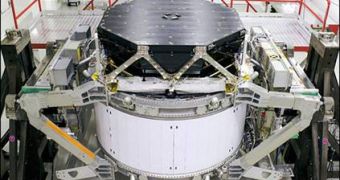Sometimes you can get a little soft and actually believe that the taxes you pay your government are used to create something useful. Well, that's not always the case. For example, in 1995, NASA commissioned the building of a device that was going to explore the origins of the universe. Said and done. However, the $1.5 billion project never got where it was supposed to go, meaning, in space. Now, officials at NASA turn their eyes back to their earlier project, in the hope that after the launch of the mission that will take the European module Columbus to the International Space Station, they would be able to resume their earlier plans.
It took more than 500 scientists from all over the world to build it, and about 12 years to complete, but due to the fact that the last ten missions to the ISS left little room for the device, the fears are now that it might never reach space, even though it was one of the most costly probes ever built in the history of NASA. The launch, on the 6th of December, of the European Module Columbus, that cost about $1 billion to build, is now somehow shadowed by the discussion regarding the grounded device.
The arrival of the Columbus module has been long expected by the scientific community, as it is designed to make studies of the effect gravity has on biological fluids and materials, while the Alpha Magnetic Spectrometer, could be used to find evidence of whether dark matter exists or not, and how it interacts with ordinary matter. The science behind AMS is considered critical in the Department of Energy scientific review; nevertheless, its faith remains mostly uncertain.
Though NASA guaranteed that it would deliver the instrument into space, it cannot be blamed for not doing so, taking into consideration all the incidents related to the space program, especially as a result of the loss of the space shuttle Columbia, that put a stop to all shuttle missions for two and a half years. However, this should have not halted the mission related to the AMS - it was rather due to the fears that the ISS would not be finished on schedule that the launch of the instrument was prevented.
NASA continues to support with fundings the build of the AMS, currently taking place in Geneva, though it is not sure if it will be able to hold its promise and put it into space. By the time the AMS is completed, NASA would have contributed with over $75 million to the project.
The space module Columbus, scheduled to fly this week, will study the effect of gravity on plants, and the dynamics of fluids, or how different crystals develop in no gravity environments. Scientists hope that the knowledge that they will gather on the Columbus could perfect the mass production of metals into space, or in weightless environments.
Nevertheless, it is not the first space laboratory to be flown to the International Space Station, as the Destiny module was flown to the ISS in 2001, and has run several experiments since then, amongst which was one that studied the salmonella bacteria and revealed it could potentially be far more distructive in space-like conditions, but also pointed towards better means of containing and treating it on Earth.
Designed for a ten-year mission, Columbus will be ready for preliminary experiments in 2009, when it will receive a crew complement of six.

 14 DAY TRIAL //
14 DAY TRIAL //